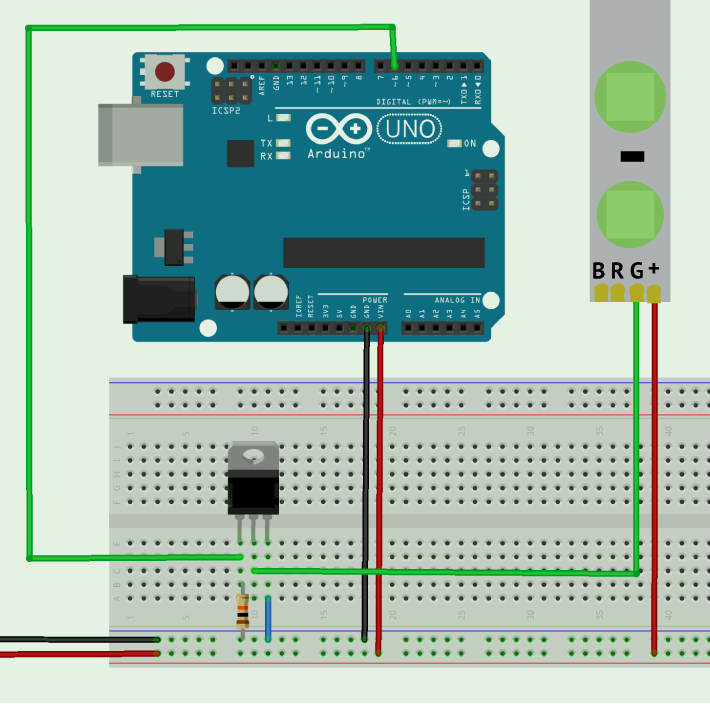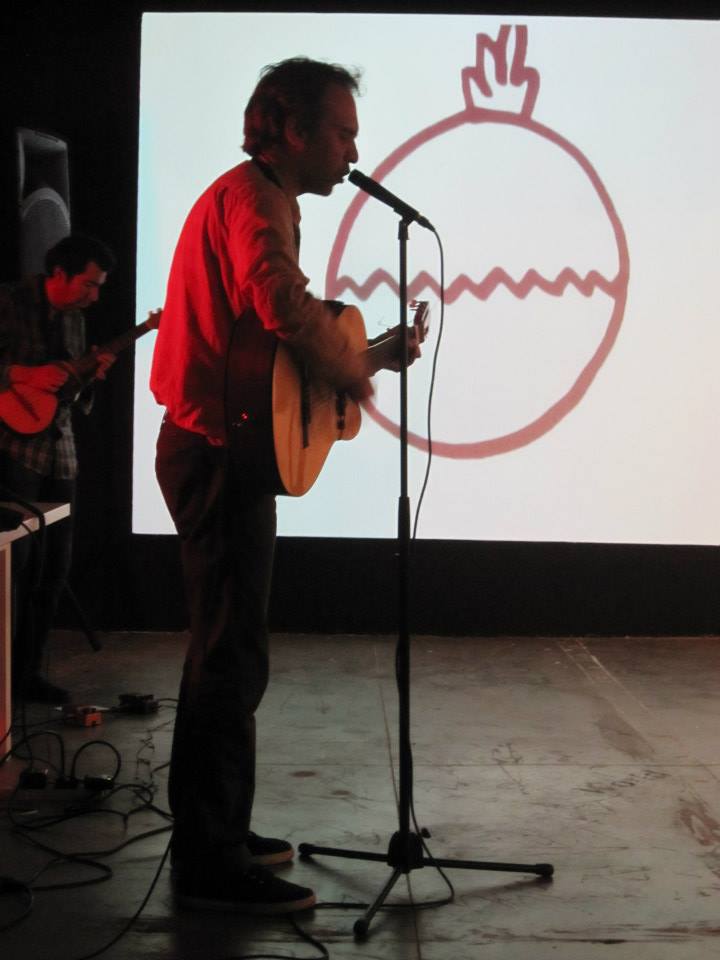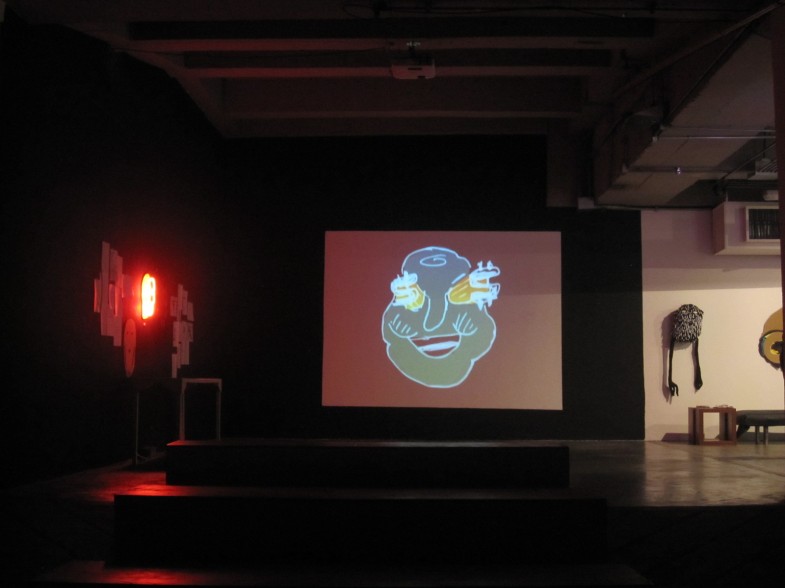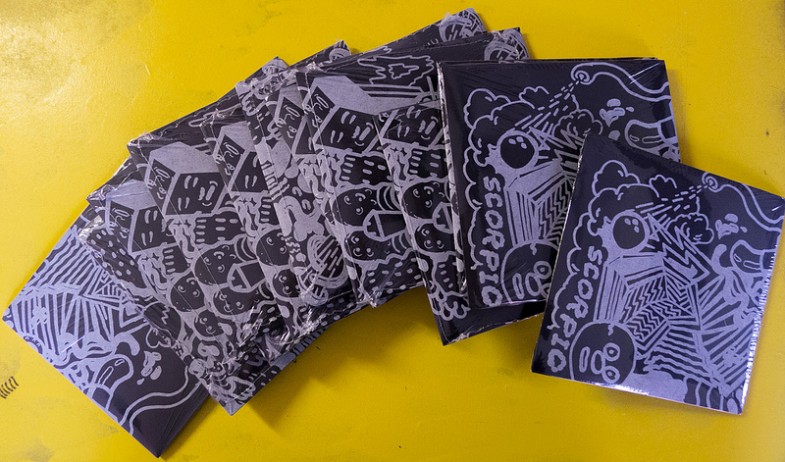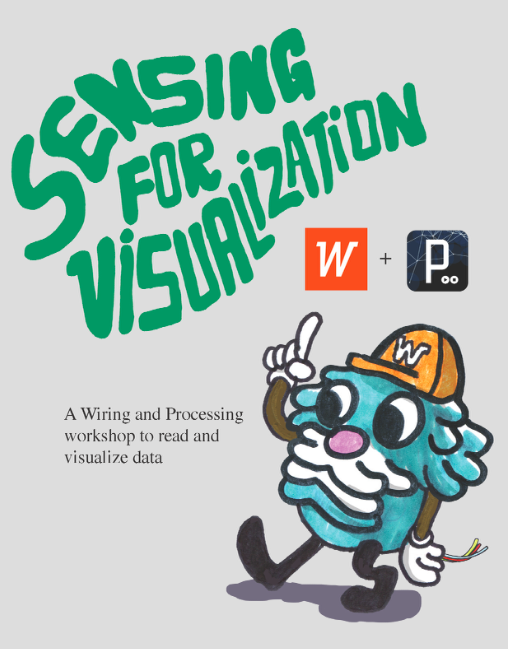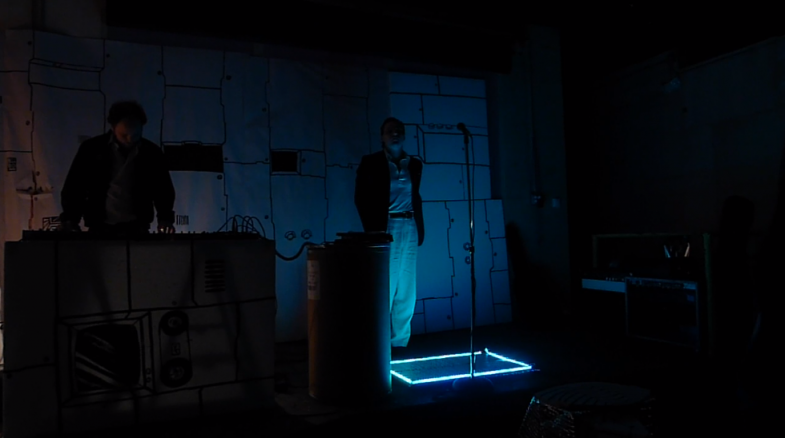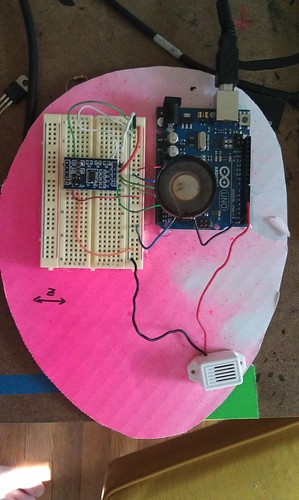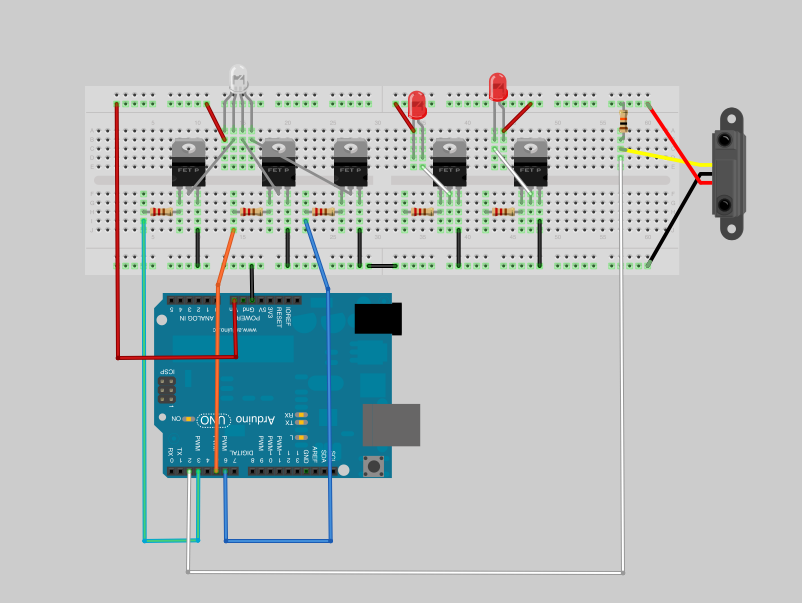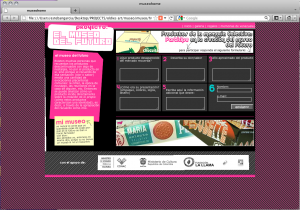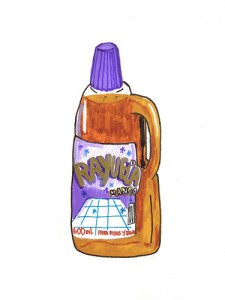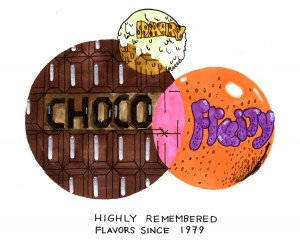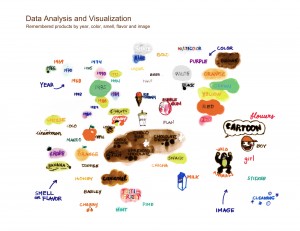After a lot of errors and burnt boards, we redesigned our circuit. This one has been the most stable so far. It also keeps real cool 🙂
RGB LED Color gamut
For the Carlson Garcia project, we were wondering about the possibilities of expanding the color vocabulary of the given 8 primary colors (RGB + complementaries) through PWM and code. Initially, we noticed that the screen values did not match the actual colors of the LED strips. It was a frustrating task to design sculptures that would display the actual colors that we envisioned. For this reason, we designed a processing application that would allow us to see how the screen colors were represented in the LED displays.
 We discovered that through PWM we could emulate a wide gamut of colors bigger than the given 8 primaries. However, the LEDs do not provide all the actual 255 values for each color. With the software and hardware like seen in the video, we are able to see how the colors will be shown in the LED hardware. This development has been very helpful to design sculptures with specific color palettes that we design. The color spectrum is not as wide as the 17 million colors of a screen, but at least we get to combine a wider number of colors. It is hard to know right now how many colors can be represented, but at least we have thousands of colors to chose from.
We discovered that through PWM we could emulate a wide gamut of colors bigger than the given 8 primaries. However, the LEDs do not provide all the actual 255 values for each color. With the software and hardware like seen in the video, we are able to see how the colors will be shown in the LED hardware. This development has been very helpful to design sculptures with specific color palettes that we design. The color spectrum is not as wide as the 17 million colors of a screen, but at least we get to combine a wider number of colors. It is hard to know right now how many colors can be represented, but at least we have thousands of colors to chose from.
The code for our app is below (Processing with arduino firmata):
/* PALETTE for Processing 2.1.2 (2015)
Use Arduino Firmata to control ports. Cnange the index number [?] corresponding to your USB port
This program works with the hardware "palette" created by Carlson Garcia
www.carlsongarcia.com
Use nobs to mix RGB values of the LEDS. Record the liked colors by making screenshots
of the combinations */
import processing.serial.*;
import cc.arduino.*;
Arduino arduino;
int red1=3;
int green1 =5;
int blue1=6;
int red2=9;
int green2 =10;
int blue2=11;
int mapvalred1,mapvalred2;
int mapvalgreen1,mapvalgreen2;
int mapvalblue1,mapvalblue2;
boolean andruinoThere = true; //Deactivate andruidno for debuggings
void setup() {
size(800, 600);
println(Arduino.list());
arduino = new Arduino(this, Arduino.list()[12], 57600); // 3 or 12
}
void draw() {
background(0);
fill(mapvalred1,mapvalgreen1,mapvalblue1);
rect(0,0,width/2,height/2); //Left Rectangle
fill(mapvalred2,mapvalgreen2,mapvalblue2);
rect(width/2,0,width/2,height/2); //right rectangle
//rect(width/2,height/2,width/2,height/2);
//rect(0,height/2,width/2,height/2);
// read analog input arduino.analogRead(0) from potentiometer, store it in a variable, map it
// and write it arduino.analogWrite(9, mappedto255);
int valred1=arduino.analogRead(0);
int valgreen1=arduino.analogRead(1);
int valblue1=arduino.analogRead(2);
int valred2=arduino.analogRead(3);
int valgreen2=arduino.analogRead(4);
int valblue2=arduino.analogRead(5);
mapvalred1=int(map (valred1, 0,1023,0,255));
mapvalgreen1=int(map (valgreen1, 0,1023,0,255));
mapvalblue1=int(map (valblue1, 0,1023,0,255));
mapvalred2=int(map (valred2, 0,1023,0,255));
mapvalgreen2=int(map (valgreen2, 0,1023,0,255));
mapvalblue2=int(map (valblue2, 0,1023,0,255));
arduino.analogWrite(red1,mapvalred1);
arduino.analogWrite(green1,mapvalgreen1);
arduino.analogWrite(blue1,mapvalblue1);
arduino.analogWrite(red2,mapvalred2);
arduino.analogWrite(green2,mapvalgreen2);
arduino.analogWrite(blue2,mapvalblue2);
fill(255);
text(mapvalred1,width/4,400);
text(mapvalgreen1,width/4,420);
text(mapvalblue1,width/4,440);
text(mapvalred2,500,400);
text(mapvalgreen2,500,420);
text(mapvalblue2,500,440);
}
Exploring 555
For the past couple of years, my friend and collaborator Aaron Zernack has been investigating audio synthesis using Current Voltage (CV/Gate) modular synthesizers. The whole thing has been very interesting to me aesthetically as sound, but also as to wonder about its potential in visualization. I have 2 modules now that allow me to experiment with analog synthesis in the visual realm. One is the Gieskes Oscillatoscope video synth and the other is the Minigorille Geometry Synth. Both of these devices have been an amazing ways of visualizing sound data and creating very exciting synesthesia art projects. However, I noticed that a lot of these synths use ATMega chips, same or similar to the arduinos. This made me think in a more conter-intuitive way. What if I could get rid of all the coding and produce synthesizers that modulate current voltage using simple electronics?
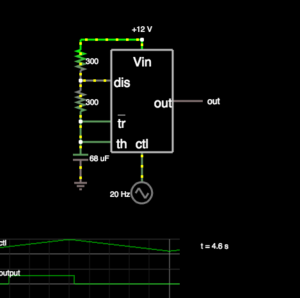
The diagram shows a snapshot of a circuit simulator of an LED fader using the 555 timer, resistors and capacitors. As you can see on the graphic we should have a smooth PWM modulation, but it ends up ramping up really fast. The video shows how the circuit is not really able to keep a consistent value, or a slow gradation of value at the least. Anyhow, This is mostly a new venue for research and experimentation. It would be really cool to simplify the circuits for my sculptures and not necessarily need to use I/0 boards for each sculpture. In this case you can see how the Red color fades in and then very suddenly it becomes white. I was hoping for a smoother transition, but nevertheless, very interesting.
RGB LED circuit
This is the circuit the right circuit to drive multiple RGB LED strips using the Arduino/wiring board. Resistor is 10Kohm and the transistor is a N-Channel MOSFET 60V 30A. Power is 12V @ 1A
Ohio 8550 art residency
Last week I was in the middle of nowhere, in a place called 8550 Ohio (formerly known as Harold Arts). The place is near a town called Chesterhill, 20 minutes from Athens, OH. The experience was magical. A group of artists (music/visual) were nominated to participate on a residency during the month of August 2013. Jason Ajemian invited me to come and there I meet with other artists that live in the midwest, specially Chicago. There I met with the other leaders of this program: Joe Jeffers and Frank Van Duerm (both badass). They were very good hosts and made sure that we had everything we needed to make good stuff. When I asked Frank if there was any way I could help needed some help with the dishes, he said : we just want you to make awesome work. With that support in mind, I adventured to get immersed in the experience of making something brand new. The studio space is a few minutes from the lodge, the place were we slept and ate.
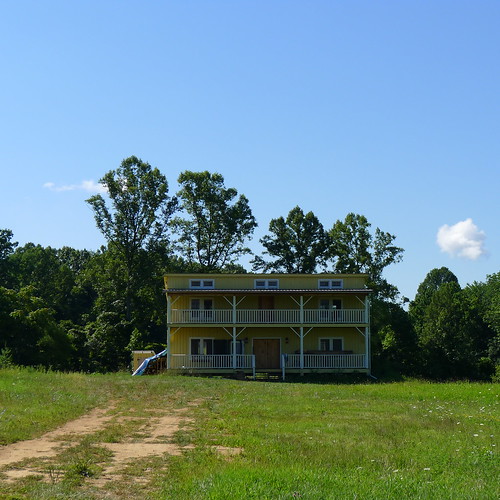
The studios are totally amazing. They were made out of wood from the farm and had 2 stories. It was great to share space with Jeff, Jessica, Ally, Dani and Molly. There were also other artists that worked on the lodge. During my time there I experimented making solar balloons. a bizarre science project that consists of making flying objects using trash bags. I have been trying to make spaceships, or flying saucers since 2010 and this occasion I succeeded in creating a working balloon.
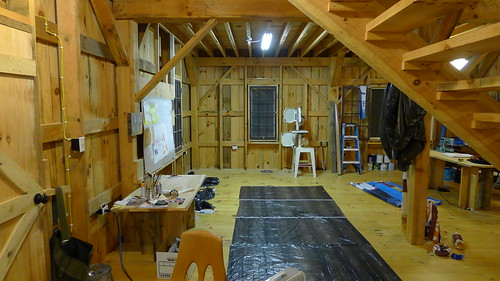
I am planning on continuing working on some more designs, but this residency gave me the space to create this large-scale experiment. In the future I hope to make some more solar balloons.
The trash bags lift because of the hot air inside it is lighter than the surrounding air. The heat is all generated by the temperature accumulated by the dark color of the bags.
The days at 8550 were wonderful. We lived in a community of like-minded artists, in a wonderful environment that had everything we needed plus a pond!
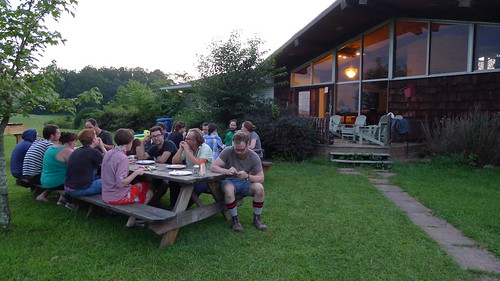
Happy artists
Exhibition in Bogotá
My friends from espacio 101/ La ramona proyectos organized an independent publication festival called C-Zine. The exhibit took place in El Parqueadero-Espacio de proyectos Museo de Arte del Banco de la República, in Bogotá Colombia. For this invitational, I asked my buddy Aaron Nemec to finalize one of our drawing projects that we had been working since 2010. The results of tracing each other’s drawings became image sequences and animations. The inspiration for the each sequence was almost surreal… Our conversations of the day, could turn into actual sequences- like in the case of the Knife-donut-hulk sequence, taken from a discussion about cutting donuts at home. The result was “Scorpio” a 3 minute animated short with hundreds of drawings in motion. The soundtrack was developed by Nemec and I, but mostly Nemec. The editing process was pretty cool. I feel like we were swaping files for a while and building it very slowly.
Las Malas Amistades performing
Scorpio in the Exhibit
C-Zine view (pictures by La Ramona)
Another part of the process with Scorpio, was to create it into an actual DVD to be more of a publication. For this matter, buddy Zern from Mine-Us print hooked us up with some pretty awesome inks. We used the limited edition prints to wrap the disc…
This was a very exciting experience of bridging Bogotá (my hometown) and Lafayette (where I’ve lived for 8 years). La Ramona and Foamcity will continue developing more cross-national exhibits in this two places this fall. After “Pizza” in 2012, we are planning a new show called GIF: graphic interchange format. Stay tuned!
ISEA 2013
I arrived to Sydney a few days ago for the ISEA. Before the conference starts on Tuesday, the event has a series of workshops with an electronic arts focus. I gave my workshop “Sensing for Visualization” yesterday and will repeat it today at 3 PM. The idea was to create a programming crash-course for physical computing. The workshop covered Processing and the Wiring board. It was cool to put the idea to a test with participants. The workshops occur at the College of Fine Arts of UNSW.
You can download the file with the workshop here
I was interested on teaching the Wiring board in the context of the Latin American Forum of the ISEA and to give information about this seminal project that preceded Arduino developed by the Colombian artist/designer Hernando Barragán. Hernando was a professor while I did my art undergrad in Bogotá at Universidad de los Andes, were he still teaches.
There are a lot cool things going on. Right now I at a workshop named SurSouth, an online collaborative conversation. It was great to reconnect with an old friend, Hamilton who now lives in London. His work is pretty cool. His objects are living organisms that exist through alchemy and technology. Check his stuff here
There we be a lot coming up. I’ll try to document other experiences of this trip. There is too much going on.
Interactive light show
I have been involved with the band Tigerfox since their very beginnings as a sort of an art director for their live performances. Last year I did some video projections of computer programs with interactive graphics. For the their new music, my friend Ryan Puetz had this grandiose vision of adding lights to their show. I was excited to create some kind of “interactive light carpet” that I could control in the background, changing colors and rhythmic patterns. I used arduino and processing to make this. If you want to see a video of the performance/music, check here
Arka-android
Ever since I went to the processing.android symposium led by Daniel Sauter at UIC, I wanted to have an android. It is fairly easy to develop applications for android mobiles using the language processing. You can find very complete documentation on the how-to’s here: http://wiki.processing.org/w/Android. You can also have access to the hardware components of the android device using the Ketai library, developed by Sauter and Jesus Duran.
I incorporated my paintings as sprites for the popular game “Arkanoid.” My idea was to make a painting into something more than painting. A playable painting?
Fallopian Tuba
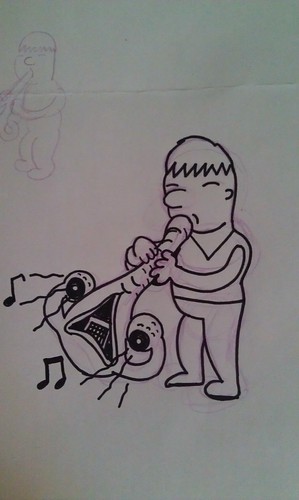
int speakerPin = 2;
int buzzerPin = 4;
int buzzer2Pin = 0;
int xpin= A2;
int ypin= A1;
int zpin= A0;
int x, y, z;
void setup() {
// initialize the serial communication:
pinMode(xpin, INPUT);
pinMode(speakerPin, OUTPUT);
pinMode(buzzerPin, OUTPUT);
pinMode(buzzer2Pin, OUTPUT);
//Serial.begin(9600);
}
void loop() {
bass();
}
void beep (unsigned char speakerPin, int frequencyInHertz, long timeInMilliseconds) // the sound producing function
{
int x;
long delayAmount = (long)(1000000/frequencyInHertz);
long loopTime = (long)((timeInMilliseconds*1000)/(delayAmount*2));
for (x=0;x {
digitalWrite(speakerPin,HIGH);
delayMicroseconds(delayAmount);
digitalWrite(speakerPin,LOW);
delayMicroseconds(delayAmount);
}
}
void bass ()
{
x= analogRead(xpin);
y= analogRead(ypin);
z= analogRead(zpin);
beep(speakerPin,500+x,89);
beep(buzzerPin,90+y,80);
beep(speakerPin,290+z,x);
//beep(buzzer2Pin,700+z,10);
// beep(speakerPin,800+x,78);
//beep(speakerPin,x*0.7,sensorvalue%5);
//beep(speakerPin,xe*0.09,400); //
//delay(1000);
}
experiencia mistica
Experiencia Mistica from Snebtor on Vimeo.
Here is the final result of my 4 month project. I feel very pleased with the result and learned a lot of new techniques in the process.
Experiencia Mistica program
In an effort to document and archive the circuit and program of the experiencia mistica installation, I publish this circuit and code, in wich a PIR (infrared motion sensor) triggers a display of a RGB LED strip and 2 strobe lights. Additionally has a 12V input and a webcam. It runs in processing with different libraries, such as Arduino, processing.video and minim for the audio
import processing.serial.*;
import cc.arduino.*;
import ddf.minim.*;
import processing.video.*;
import gifAnimation.*;
Minim minim;
AudioPlayer player;
Arduino arduino; //creates arduino object
Capture cam;
Gif tunel;
//variables for PIR
int PIRPIN = 2;
int ledPin = 13;
int counter;
//Variables for RGB strip
int REDPIN= 5;
int GREENPIN= 3;
int BLUEPIN= 6;
int r, g, b;
//Variables for R L strobes
int LEFTPIN =9;
int RIGHTPIN=10;
float leftChannel;
float rightChannel;
float soundValLeft;
float soundValRight;
void setup(){
size(800, 600);
colorMode(HSB);
tunel = new Gif(this, "tunel.gif");
tunel.loop();
cam = new Capture(this, 160, 120);
arduino = new Arduino(this, Arduino.list()[0], 57600);
arduino.pinMode(PIRPIN, Arduino.INPUT);
arduino.pinMode(ledPin, Arduino.OUTPUT);
arduino.pinMode(REDPIN, Arduino.OUTPUT);
arduino.pinMode(GREENPIN, Arduino.OUTPUT);
arduino.pinMode(BLUEPIN, Arduino.OUTPUT);
arduino.pinMode(LEFTPIN, Arduino.OUTPUT);
arduino.pinMode(RIGHTPIN, Arduino.OUTPUT);
minim = new Minim(this);
player = minim.loadFile("mystica2.aiff", 1024); //or 2048
player.play();
}
void draw(){
int pirVal = arduino.digitalRead(PIRPIN);
if(pirVal == Arduino.LOW){ //was motion detected
counter ++;
if (counter == 5){ // the sensor has to be triggered at least 5 times to detect strong motion
arduino.digitalWrite(ledPin, Arduino.HIGH);// send the siignal
player.play();
background (255, 0, 0);
//delay(2000);
}
}
if(pirVal == Arduino.HIGH){ //was motion detected
counter=0;
arduino.digitalWrite(ledPin,Arduino.LOW );
background (0, 0, 0);
}
if ( !player.isPlaying() ){
player.rewind();
}
if ( player.isPlaying() ){
for(int i = 0; i < player.bufferSize() - 1; i++) {
soundValLeft= player.left.get(i)*150;
soundValRight= player.right.get(i)*100;
}
int soundintL = int(soundValLeft); // int version of sound value
int soundintR = int(soundValRight);
arduino.analogWrite(LEFTPIN,soundintL);
arduino.analogWrite(RIGHTPIN,soundintR);
cam.read();
image(tunel,0,0);
image(cam, 322, 236);
if (g==255){ // loop for green variation
g=0;}else g++;
tint (g, 255, 255);
if (r==200){ // loop for red variation
r=0;}else r++;
arduino.analogWrite(GREENPIN,g);
arduino.analogWrite(REDPIN,r);
arduino.analogWrite(BLUEPIN,soundintR);
}
}
Experiencia Mistica
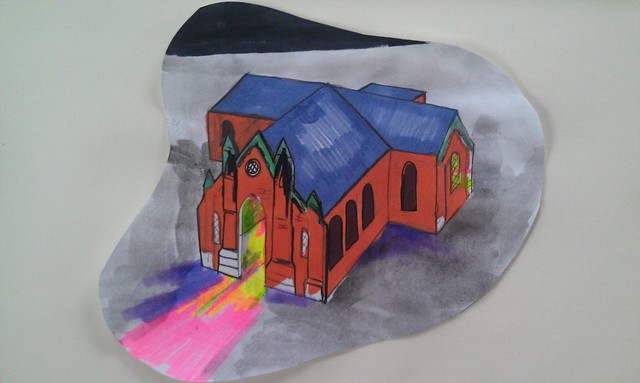
First sketch with the idea.
Okay, so I have embarked in a project that involves a lot of work, research and skill. A lot of people have seen me working at foamcity in a “church” or “castle”, but in reality is my Experiencia Mistica project. My motivation to do this project is an image that came to me a long time ago. This image is a three dimensional model of one of Lafayette’s churches. After that I started thinking about the most appropriate material to do a huge 3D model and after making 2 giant plywood structures in December, I went for plywood for this project. I have been obsessed with geometry for a while and during my PhD I’ve been exposed to visualization techniques and geometric modeling. I also teach a visualization class and Dr. Miller’s orthographic teachings came in very handy in the development of the model:
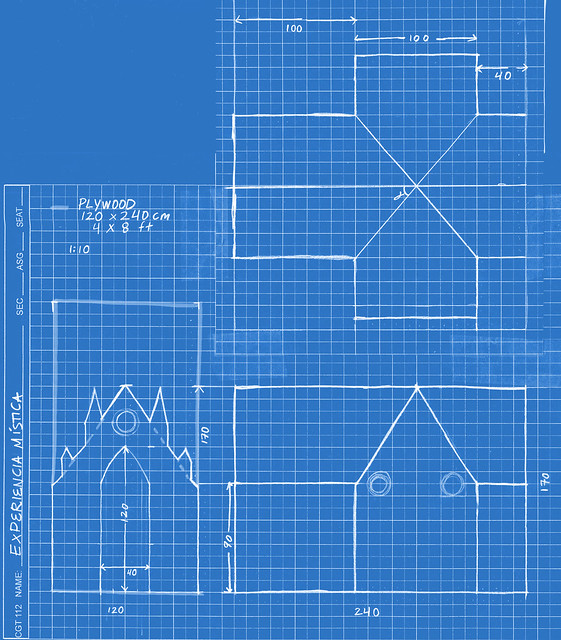
Max helped a ton with his knowledge and tools and we put together the main geometry in only 2 days! It was great. Now I am in the process of painting the outside and it’s been already a month of heavy work. This is how it looked last week:
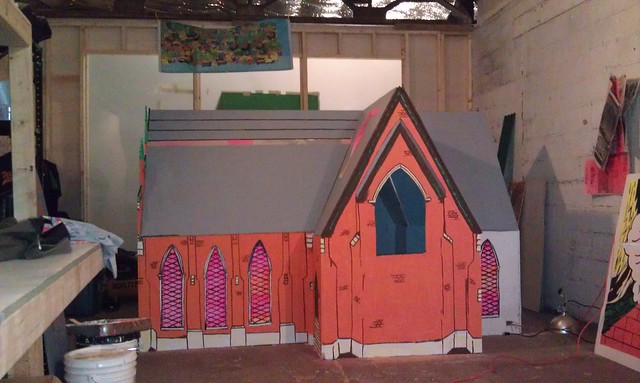
Since then I have repainted a lot of the early lines because I was not happy with the way the geometry looked kind of flimsy. The video on top shows a program for controling the lights inside via arduino. There is so much to be done!
Museo del Futuro
- Which of the disappeared products you remember?
- Describe it’s Flavor/Smell
- Year
- How was the design? (color, logo, etc.)
- Any additional information?
I received 54 entries. The submissions were used to create visual representations of these memories based on the given information. However, this project was unfinished since only 30 of the products had been visualized. A few weeks ago I found an old stack of papers and with the Museo del futuro drawings in it. Under the light of the topic of “data visualization,” I gained interest on this project on a different level. This time I wanted to analyze this data through the lens of qualitative research and to produce visualizations for it.
fruity, chocolate, colorful, childhood, spicy, sweet, cheesy, fresh, chewy, drink, snack, bubblegum, candy, ice cream, cookie, beer dairy, milk chocolate, spreadable chocolateThe visual results are below:
Summer plans and trips
I’ve been excited and even nervous about the upcoming events this summer starting in just a couple of weeks. Last Feb. I submitted the Revenge eternal documentation to a festival called LPM in Rome. Pretty soon we got informed about our acceptance in the new media festival for audiovisual performance.
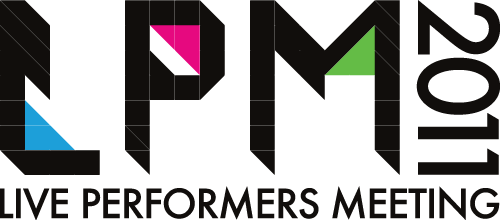
Jordan and I will be traveling in two weeks to Rome and stay 5 days there for the duration of the event. We’re part of the “RE-Encode” selection for this year, curated by Andrea Sztojánovits. according to the page RE-Encode is:
Generative art is an expressive and increasingly explored genre, particularly thanks to the last decade’s technological novelties. The vj became a programmer and the programmer mutated into a performer, capable of creating incredible digital biospheres; a new era of sound and codes have produced novel organic visual experiences. From computer to physical and portable devices, many tools are available to creators and designers which contribute to the technological and artistic development through generative audiovisual language. Thanks to an active and reactive coding of the world surrounding us, the audience can perceive a unique atmosphere, experiencing complex performances of simple bits and binary codes.
I guess what we do fits into that category, since we use computer code to alter and produce audiovisual content.
Another exciting event is the one coming up in August. My paper entitled “Art and code: The aesthetic legacy of Aldo Giorgini” was selected for SIGGRAPH 2011 Vancouver. I am excited to present my research and a little bit scared about learning the required presenter/entertainer skills.
It has been a great semester so far and the fruits of my work are starting to bloom. After being rejected from a lot of applications to art residencies and bad luck with shows, I get to fulfill 2 of my dream goals for 2011. I have learnt a lot about growing up as an artist and realizing that the road is gonna be long and interesting. The accomplishment of goals is the beginning of new ones. As far as the PhD, I will be working in my research about Aldo Giorgini with great help of my Advisers, Dr. Whittinghill, Dr. Miller and Dr. Mohler. Additionally, The College of Technology will cover the costs of my research during the summer which is freakin’ awesome.
I would like to encourage other creative artists to persist on their quest to sustainability (economic-integrity-happiness) because it can happen to you. The way the art world works is pretty weird and the chances of becoming “a great artist” are pretty slim in our contemporary world. But, if you can be sustainable, then you’re an artist.
Banana DOOM – Videogame mod project
During the past year I’ve been programming my own videogames using the tool called Unity. It is a free engine, and very compatible with the opensource 3d modeling tool wings. I never had used 3D before and it was easy to just start working on it after a workshop organized by ETB and the envision center at Purdue. Besides that, I have been using other game engines for 2D “modding”. Modding means making modifications or ‘mods’ of preexisting games changing the original assets of the game. An example of this is the M.U.G.E.N software that contains the program of a 2-player fight game similar to Mortal Kombat and Street Fighter II. I experienced modding it with an engine called Fighter Factory ultimate. I obviously had to get a machine with windows XP (service pack 3) in it. Anyhow it’s a lot of fun to remove the original graphics and replace them with my own drawings. One example of modding in FFU and M.U.G.E.N. is my Cortez character:
My next modding project consists of moding the historic first-person shooter DOOM. For this I am using a .Wad file called freedoom, a free version of the doom software. A WAD is the extension file of the game files. WAD stands for “Where is All the Data” and it is part of the doom software. You can edit this files using doombuilder and Xtendable WAD editor… both PC shareware/freeware.
I like to use preexisting game plots to raise awareness of historic events. In the case of my Doom WAD, I am creating BANANA DOOM, a game that retells the “masacre de las bananeras” or Banana Massacre in Colombia (1928). You are one of the soldiers that were order to kill 1000+ unionized farmers and their families. The unionized workers pressured the american corporation “United Fruit Company” to get better job conditions. The goverment officials threatened workers to kill them if they didn’t resume their banana collection. A threat that became true and has become one of the landmarks in the history of violence in Colombia.
Here is a video of my WAD replacing the tree sprites with Banana plants:
And one of the sprite ideas for the farmer character will be coming soon. It looks like this:
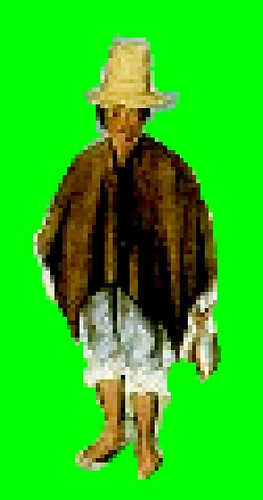
I am using archival images to make the sprite art. But one of my friends will be the Farmer actor.
Audiovisual performance: revenge eternal
I just came back from Indianapolis. Last night we played in a place called “Earth House”, a venue for independent visual artists and performers. It is located downtown “Indy” a few blocks from our friends Jordan, Ryan and Benedict. It was a lot of fun. Unfortunately, one of the members of revenge eternal couldn’t come to our show and we had to adapt the sound material a little. Here is a picture of the auditorium where we played at:
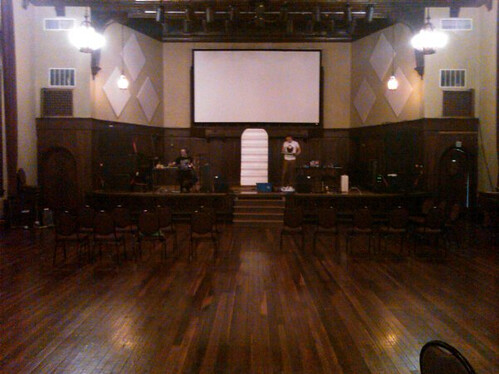
The show was booked by Erin Drew, a very interesting visual artist that I met a couple of years ago through a Meatballz show in Zonie’s closet, Indianapolis. Aaron and I got there and we were surprised that we were playing at a very old methodist? church. erin did a very cool flyer for the event too:
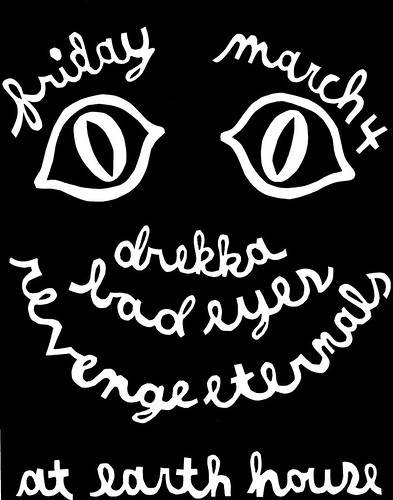
There was a big group of friends from the Lafayette infamous scene and their presence didn’t remain unnoticed by the public attending to the event. The consumption of alcoholic beverages was frowned upon by one of the organizers of the event. Anyways, our show seemed to have a receptive audience and we also enjoyed the other bands on the show: Bad eyes and Drekka. I really hope we get to get around with the revenge eternal project. I just want to have something else than research. I am more of an artist than a researcher and I want to keep my interests well balanced. We will play 2 shows next friday in Lafayette, our hometown. we’ll see how that goes.
Here is a video documentation of the revenge eternal performance days before the earth house show:
Biotech Manimal
My recent project is a comic called “Biotech Manimal”. It tells the story of Rich, a grad student exploited by his professors. While doing some experiments at his lab, Rich’s molecular structure blend with a BIO-enzime. The Zine will be out soon, but you can read the first 3 pages by clicking in the picture below:

This is the comic is the result of my question about technology. What is the impact (causa eficiens) of technology? This question cannot be simply answered.


